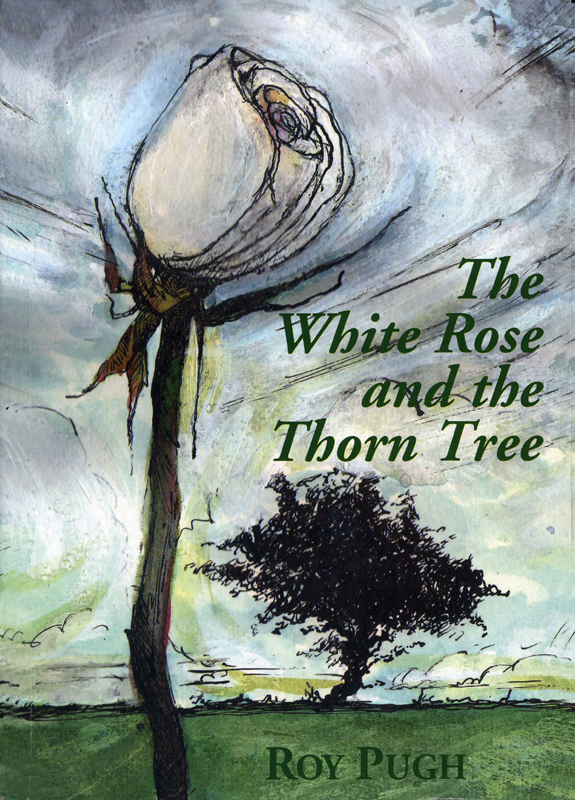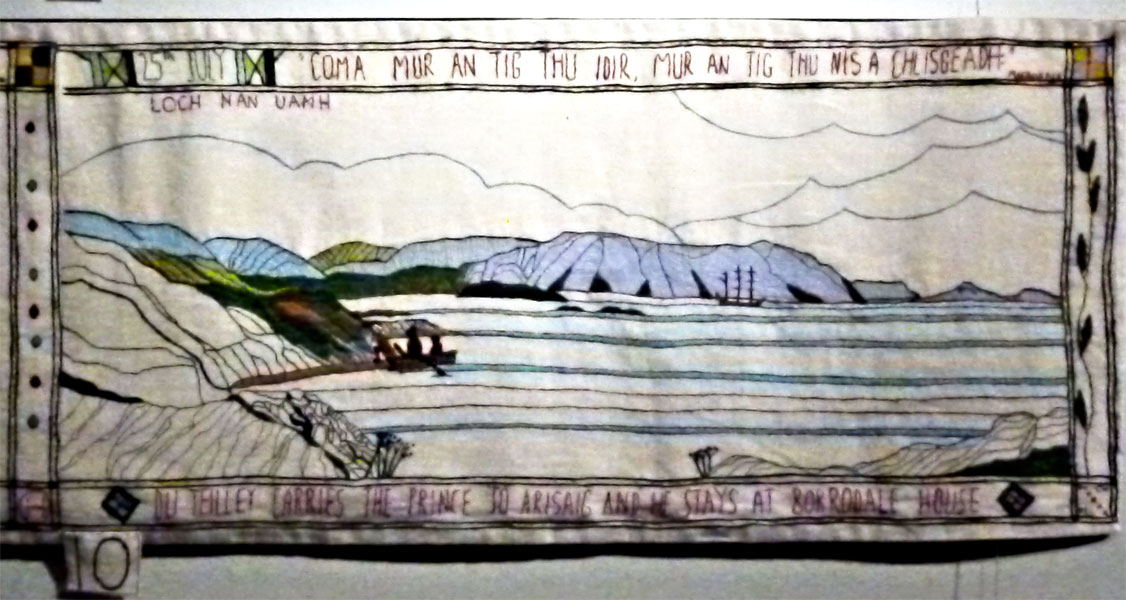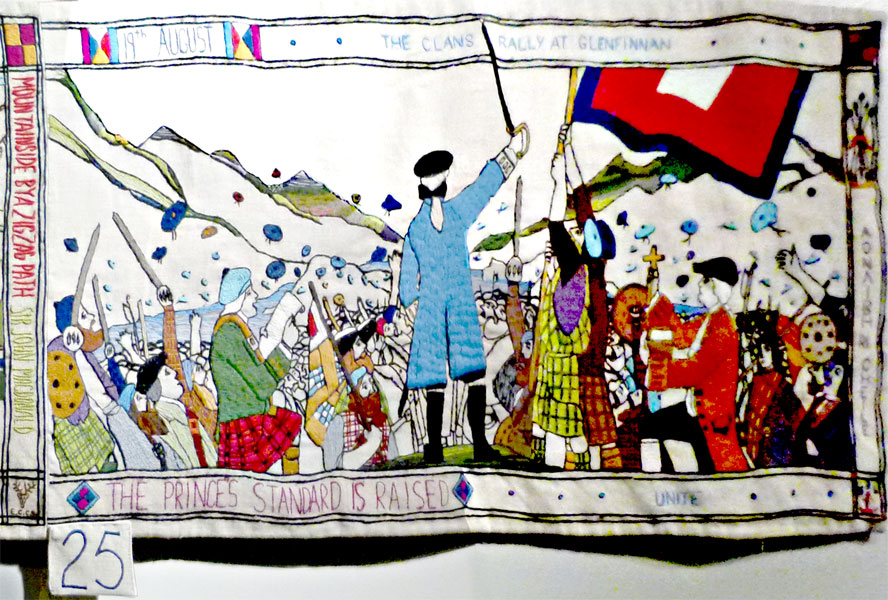Hi everybody,
Our recent visit to the Bayeux Tapestry Museum which temporarily shelters the magnificent Prestonpans Tapestry, made me want to know more not only about the tapestry itself and the people who contributed to the creation of this great masterpiece but also about the journey of Bonnie Prince Charlie from Rome to Prestonpans and beyond…
http://www.tapestry-bayeux.com/index.php?id=1&=&L=1
The Prince had a dream…
I am not an expert in Scottish history, far from it, so I was very happy to learn about the three Scottish tapestries which so marvellously illustrate this history: The Battle of Prestonpans Tapestry 1745 completed in 2010, The Great Tapestry of Scotland recently inaugurated in Edinburgh and The Diaspora Tapestry which should be finished for the Homecoming 2014 Celebrations. From panel to panel, these tapestries, longer than the Bayeux Tapestry which inspired them, can be read as the pages of an illustrated book, with English and Gaelic texts describing events like newspaper headlines.
Since our visit to Bayeux I’ve added a few interesting volumes to my Scottish library 😉
The book is described on its cover flap as ‘The Definite Guide to the Prestonpans Tapestry & the stories of those who created it for the Nation’ and when I received it I was surprised by its size and weight. It is a big book which contains a great story, or I’d rather say several stories. This fascinating book allows those who didn’t see the tapestry to discover it and the lucky ones who saw it (I did) to re-visit it with much pleasure for it describes in detail the 104 panels with page-length photos of each of them! Beyond the story of Bonnie Prince Charlie which is one of the most moving pages of Scottish history and which is the subject of the tapestry we can read there the stories and moving testimonies of the very talented volunteers who devoted so much of their time to embroider this masterpiece. A lovely book! A feast for the eyes !
Hundreds of hands moving to a shared goal across the Scottish nation have made the point. They have stitched for more than 15,000 hours to create the world’s longest embroidered artwork at 104 metres – The Prestonpans Tapestry. Their stunning creation shall surely be our beacon for generations to come.
(The concluding words of Dr Gordon Prestoungrange in his Foreword of The Prestonpans Tapestry)
This is the story of a country and of how that story came to be told in an extraordinary and beautiful work of art. The details of how the Great Tapestry of Scotland came into the existence are set out in this book by Alistair Moffat and Susan Manfield. Their account describe how this is the result of the hard work and dedication of many hundreds of people throughout Scotland, the stitchers, but we must not forget that behind this great communal work there stand three poeple who should be regarded as the creators of this wonderful treasure: the artist, the narrator and the maker. The artist is Andrew Crummy (…) This tapestry is, quite simply, a masterpiece, and it is Andrew’s vision that lights it from the very first panel to the last. (…)
Then there is the historical vision. This tapestry has a narrative, and that is the creation of a writer, Alistair Moffat, who has a profound understanding of Scottish history and who has the ability to communicate that understanding to people. (…)
The maker is Dorie Wilkie. The telling of Scotland’s story here is a matter of needle, thread and linen. (…)
There are many others who have done so much to create this result, that it would be impossible to thank them all. But here it is: we have it now – an inspiring and beautiful thing, an expression of love for a country, a gift from many hundreds of people to those who will see it and enjoy it in the future.
The above text is an extract from the Preface of the book and it is written by… Alexander McCall Smith! For a modest price this very interesting book offers great content and I can’t but recommend what the author of ‘The No. 1 Ladies’ Detective Agency Series’, encourages you to do : Please look at it, whether you see it in the flesh or in the photographs of this book. Please enjoy it and think of the lives of the people whose story it tells. This tapestry brings us face to face with them and reminds us, I think, of who we are and of what our history means. The people we see in this tapestry are, after all, ourselves.
This tale begins the moment young Roderick MacDonald meets Bonnie Prince Charlie on the beach at Eriskay and ends with him reminiscing with a journalist in the USA in the evening of his life. Much of that life is shared with the virtuous and endearing Anne Trotter, keeper of the The Tappit Hen public house in Edinburgh when they first meet, and as his wife when they flee together ofr their lives after Culloden. Roderick’s insights are those of a youthful idealist but as the Prince’s constant companion and frequently his trusted messenger.
They experience the horrors of the struggle between The Prince’s Jacobite followers and the supporters of The Union and King George II – from July 1745 till April 1746. Yet they are not the only raconteurs. Major John Whittle has been seconded to Sir John Cope’s army to send intelligence back to London on the campaign’s progress and does so with considerable understanding of the difficulties the redcoats face at Prestonpans.
With the exception of these fictitious characters, the novel takes great care to depict the real life adversaries as they were and because of this the book is not only an enthralling tale but a truly authentic education as well.
But now, back to the Prestonpans Tapestry. Let us follow Bonnie Prince Charlie from Italy to France and France to Scotland…. it’s a great page of Scottish history…
July 25th / August 11th: the Du Teillay carries the Prince to Arisaig and he stays at Borrodale House
[Panel 10] was embroidered by Christine Haynes and Pauline Elwell who both stay in Morar close by its famous silver sands. Ann Lamont, editor of Westword, invited us to create a panel after a visit to Arisaig by the Battle Trustees in 2009. We have been greatly pleased by the whole experience and the end result.
Each panel has been very nicely embroidered by a volunteer, each embroiderer giving his or her personal touch but in keeping with the spirit of the tapestry.
Below is the text as it appears in the first 25 panels, telling the adventures of Bonnie Prince Charlie as he moves forward from Rome to Glenfinnan…
- Charles bids farewell in Rome to his father, King James VIII & III
- Storms destroy the French invasion fleet in 1744 so Charles makes his own plans in secret
- The Prince Embarks from France for Scotland aboard Du Teillay – June 22nd
- 700 French soldiers go aboard L’Elisabeth at La Belle Isle which sets sail with Du Tellay – July 5th
- L’Elisabeth engages in sea battle with English Lion – July 9th
- L’Elisabeth and Lion both badly damaged and head for port – July 9th
- Du Teillay sails on to Scotland – July 9th
- Du Teillay anchors and the Prince as a priest comes ashore – July 23rd
- Alexander MacDonald advises against the planned campaign but Prince determined – July 24th
- Du Teillay carries the Prince to Arisaig and he stays at Borrodale House – July 25 th
- Letters are written to Clan Chiefs asking for their support – July 26th
- Clanranald warmly welcomes the Prince – July 26th
- The Prince awaits the Clans at Borrodale
- The Prince orders the Du Teillay to unload & Depart – July 27th
- Lochiel comes to Borrodale 30 th
- The Prince arrives at Kinlochmoidart House – August 11th-17th
- John Murray of Broughton arrives at Kinlochmoidart House – August 11th-17th
- The Seven Men of Moidart
- Cope organises the baking of the bread in Edinburgh – August 16th
- Donal MacDonnell of Tirnadris leads capture of redcoats after action at Highbridge – August 16th
- Galley boats depart from Dalilea Pier for Glenfinnan on Loch Shiel – August 18th
- Galley Boats arrive from Glenaladale at Glenfinnan – August 19th
- Sir Cope leaves Edinburgh heading for Fort William – August 19th
- Lochiel arrives at Glenfinnan – August 19th
- The Princes Standard is raised – August 19th
After a rough and perilous crossing of the Channel (Panels 3 to 9) aboard the Du Teillay 1st landfall of Bonnie Prince Charlie in Scotland, on a little beach in Eriskay known as The Prince’s cockleshell Strand – in his disguise as a priest – (Panels 8 & 9)
It was in the year of Our Lord 1745, on a day of mist, rain and bitter winds that a young lad was visiting his father’s friend Angus MacDonald on the small island of Eriskay in the Outer Hebrides. A wild day of driving rain and gales that could sweep a man off his feet. Roderick MacDonald took shelter from the wind in the granite-strewn hollows near the sea, hoping to catch sight of the ferry boat that would carry him back to his father’s croft on South Uist. In his heart, he knew that the severe weather would force him to spend another night in Angus MacDonald’s dwelling, a smoke-filled ‘black house’ formed of granite boulders so well fitted that there was no need of mortar to keep out the elements. With its sod roof battened down by ropes weighted with stones it was a snug, if crude, dwelling house.
As he lay in the lee of a great granite stone, sheltering from the gale, Roderick saw a ship emerging from the dense fog. He watched its progress although from time to time it would suddenly vanish when swallowed up by the fog, only to appear a few moments later, closer to the shore. He knew the ship was a frigate as his father had taught him to identify vessels of different shapes. The frigate had gun ports, and Roderick counted nine on the starboard side, which told him that she was an 18-gunner. Although it flew no flag, Roderick knew it was not an English vessel.
(…)
The man standing in the prow of the boat wore the garments of an abbé…. He stared ahead, tall, erect and with a fine bearing.
(…)
Then the wind blew open the leading man’s soutaine, or cassock, which was unbuttoned. Underneath, he saw that the man wore a blue coat, cream-coloured breeches and a white shirt with a lace stock. On his breast was some kind of decoration or ornament but he was too distant for Roderick to make out how it was fashioned.
(From The White Rose and the Thorn Tree by Roy Pugh – Cuthill Press 2008)
Clanranald Warmly Welcome the Prince at Borrodale – July 26th
Despite the reluctance being shown in many quarters, Clanranald had no doubts that if the Prince was amongst them they must give all the aid they could. The whole neighbourhood at Arisaig without distinction of sex or age came to Borrodale to acknowledge him.
The Prestonpans Tapestry 1745 Burke’s Peerage and Gentry 2010
Hum… there must have been a mistake in the numbering of the panels at the Bayeux Museum… this panel should not be numbered 14 but 12: ‘ Clanranald warmly welcomes the Prince’
The panel was started by Edith Smith of Musselburgh with its embroidery completed by Audrey Brown from North Berwick and Margaret Holm of Gullane. Edith is a member of Fibretrix – an artistic group of ladies who work experimentally in different textile mediums and who all played a part in the embroidery. Margaret and Audrey are both keen stitchers and were members of creative embroidery classes at North Berwick Community Centre.
http://www.prestonpanstapestry.org/tapestry/the_tapestry_dev.aspx
Prince awaits responses to his letters
[Panel 13] was embroidered in Inversek by Ann Fraser [Scott-Kerr] who studied drawing and painting as a mature student at Edinburgh College of Art. Lady Ann’s botanical painting has often been honoured by the Royal Horticultural Society. She read an article in East Lothian Life on the Prestonpans Tapestry and wanted to become involved because many of her ancestors were Jacobites. ‘My family home was Sunlaws [now The Roxburghe Hotel] near Kelso where the Prince slept 4th/5th November en route to Carlisle and he planted a white rose tree’. Lady Ann’s tag is appropriately The Jacobite Rose depicting not only her family’s allegiance to the Jacobite cause but also her career as a botanical artist.http://www.prestonpanstapestry.org/tapestry/the_tapestry_dev.aspx
August 19th: Cameron of Lochiel arrives at Glenfinnan
[Panel 24] was embroidered by Esther Sharpley whose love of the Highlands that rose for the Prince knows no bounds. She has walked in all seasons those very lands across which the Prince travelled – not least those of Cameron of Lochiel. To stitch this panel was especially rewarding as well as the links with so many other embroiderers across Scotland. Her tag is the Stag’s head of her Clan MacKenzie.
http://www.prestonpanstapestry.org/tapestry/the_tapestry_dev.aspx
Glenfinnan is one of our favourite places in Scotland. We’ve gone there several times but the weather was particularly beautiful this day, in 2003…
We stayed a long time in the area, waiting to see the famous Harry Potter’s steam train crossing over the magnificent old Glenfinnan viaduct which was built between 1897 and 1901 in one of the most beautiful and rugged landscapes of the Highlands…
WOW ! Here it is… as if emerging from olden times, with its gleaming black engine proudly crossing the mountainous Highlands scenery amidst purple heather…
No chance for Bonnie Prince Charlie to travel aboard this lovely train though it has been called since ‘The Jacobite’ 😉
The Jacobite train was used by Warner Brothers as the Hogwarts Express in all the Harry Potter films… maybe a film was being turned the very day we travelled there for while we were trying to follow the train aboard our car we noticed that many other people were doing the same, stopping here and there to take photos, while a helicopter was flying just above the train…
August 19th:The Prince’s Standard is Raised by the Jacobite Duke of Atholl
[Panel 25] was embroidered [l/r] by Sandra Casey, Sandra Provan and Ruth Casey of Fort William. Sandra Provan created the intricate main figures on the tapestry whilst Sandra Casey and daughter Rachel complemented her by stitching the outline and lettering. The panel has been enhanced by the personal support of Donald, Cameron of Lochiel, who hosted a number of stitchers from Lochaber at his ancestral home at Achnacarry. He gave them all great insight and guidance on the history of the ‘45 and enhancing details of Jenny Cameron and the colour of some of the banners.
http://www.prestonpanstapestry.org/tapestry/the_tapestry_dev.aspx
We’ve taken only a few pictures of the Prestonpans Tapestry and our selection is of course rather frustrating because there are so many more panels to discover. The only way to make a good idea of the whole tapestry is to visit the website of the Prestonpans Tapestry or to buy the book and, or, the DVD. 😉 Personally, I will complete my collection next month for my October book budget dangerously tends towards zero ;-). Anyway, I don’t regret my purchases. I’m still waiting for A Backward Glance, the first of two novels written by Sharon Dabell and recommended on the Prestonpans Tapestry website.
http://www.prestonpanstapestry.org/tapestry/
Bonne lecture!
A bientôt. Mairiuna

















[…] reading your great article about the magnificient Prestonpans Tapestry: the Prince’s journey up to Glenfinnan… I wondered if postage stamps were issued to commemorate this milestone in Scottish […]
[…] reading your great article about the magnificient Prestonpans Tapestry: the Prince’s journey up to Glenfinnan… I wondered if postage stamps were issued to commemorate this milestone in Scottish […]